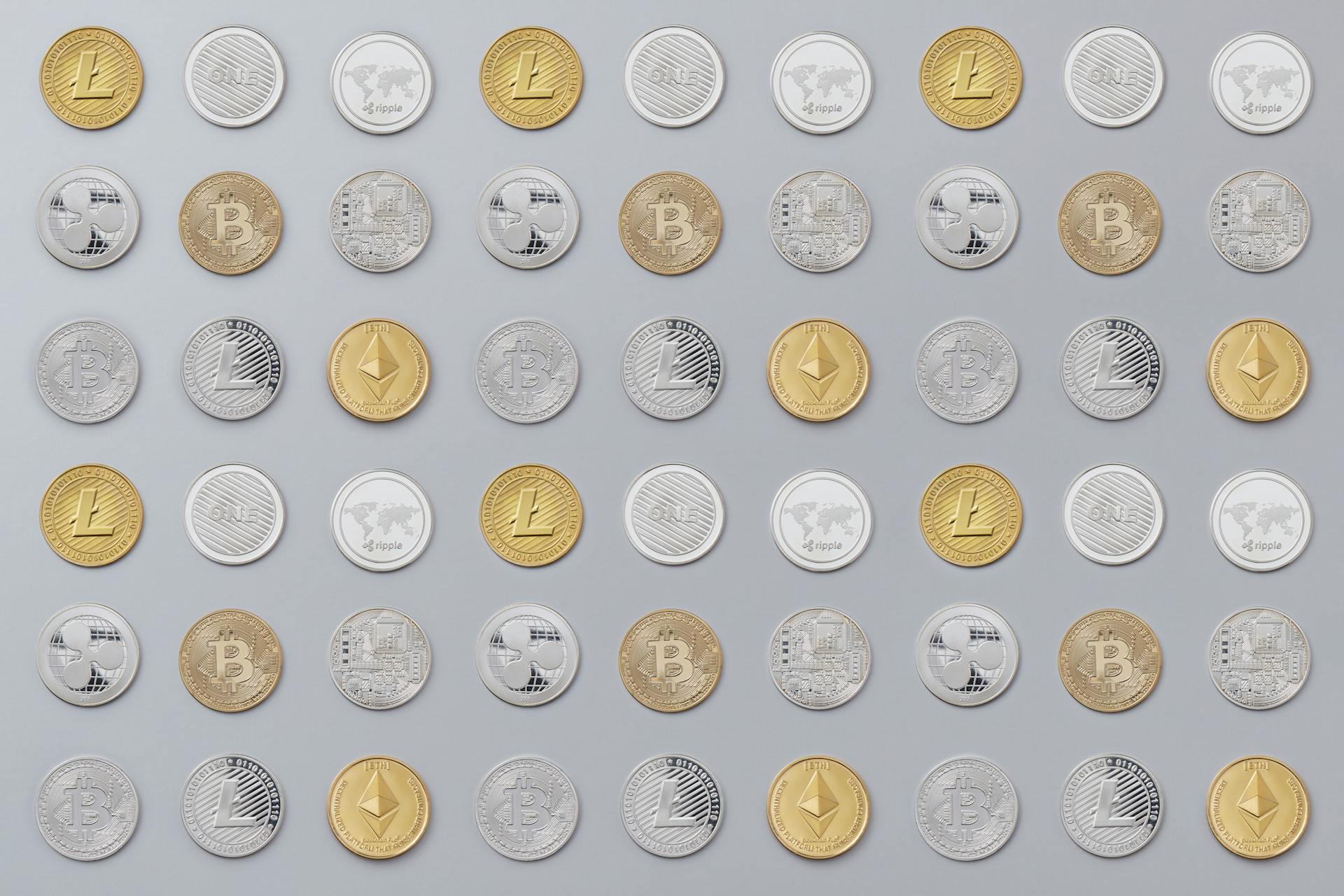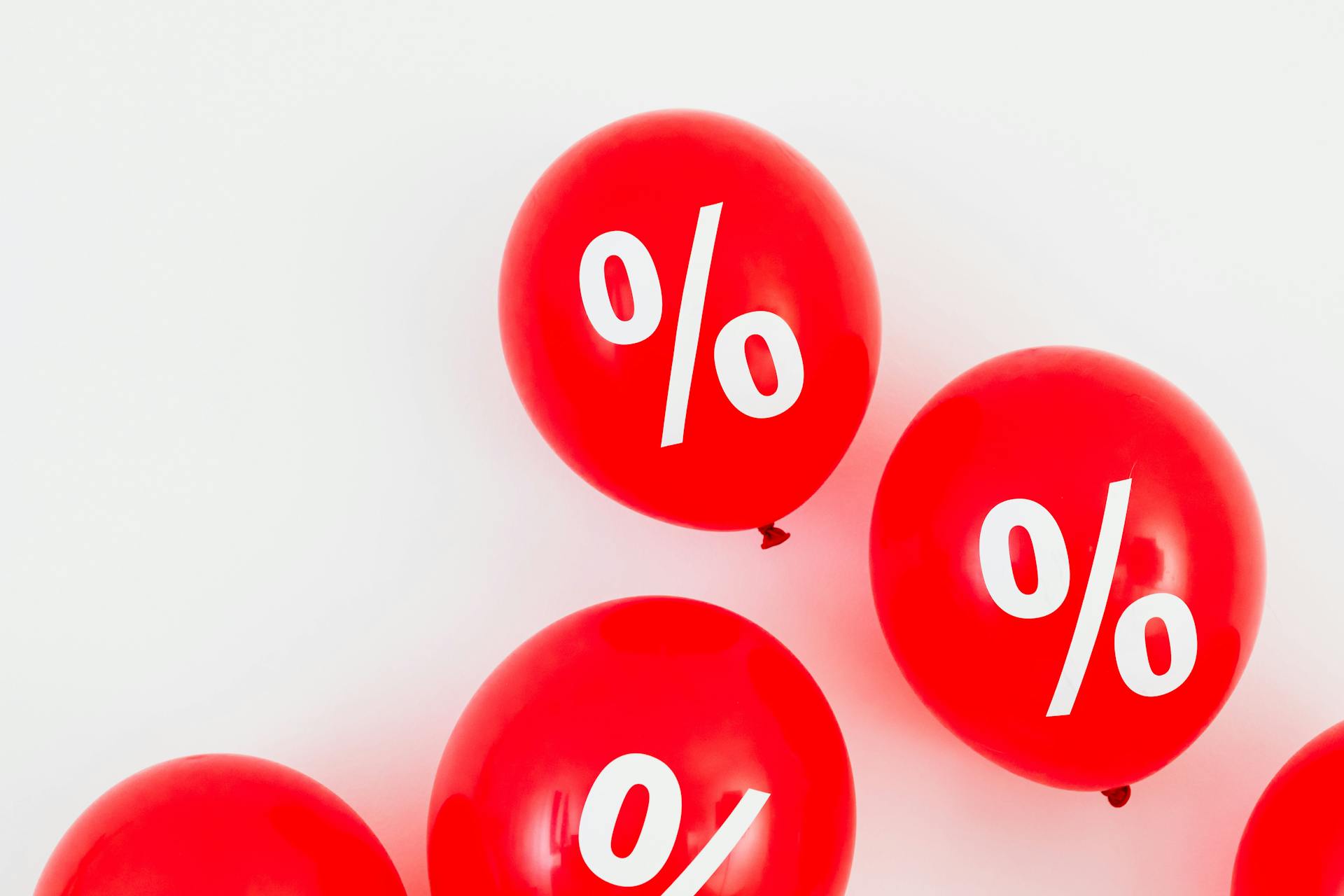
Airdrops are a great way to get your hands on some cryptocurrency, and the best part is that they're often free. You can receive airdropped tokens simply by holding a certain amount of another cryptocurrency in your wallet.
The first step in participating in an airdrop is to make sure you have a compatible wallet that supports the airdropped token. This is because some airdrops are only available to users of specific wallets or exchanges.
Airdrops can be a fantastic way to discover new cryptocurrencies and potentially get in on the ground floor of a new project. They can also be a fun and exciting way to participate in the cryptocurrency community.
You might enjoy: New Cryptocurrencies
What Is Airdrop?
An airdrop is a marketing initiative used by DeFi and Web3 projects to distribute free coins or tokens to eligible users.
It typically involves sending tokens to the wallets of users who meet certain criteria.
Airdrops can be used to reward followers or for completing certain tasks, such as referring new users to a platform.
The concept of airdrops is similar to giving away free samples, it aims to generate interest and encourage users to engage with the company or project.
On a similar theme: What Are Cryptocurrencies Used for
History of Airdrop
The concept of airdrops has its roots in the early days of cryptocurrency, with some of the earliest instances occurring in the Bitcoin community. The term "airdrop" gained popularity with the advent of alternative cryptocurrencies (altcoins) and initial coin offerings (ICOs) around 2017.
The first crypto airdrop was attributed to AuroraCoin (AUR) on March 25, 2014, where every citizen or permanent resident who submitted their national ID received 31.8 AUR. This airdrop aimed to promote AuroraCoin as the cryptocurrency for the nation of Iceland.
ICO Era
The ICO Era was a pivotal time for airdrops, marked by the 2017 ICO boom. Many blockchain projects used airdrops as a marketing strategy to create a wider user base and incentivize early adoption.
During this time, some projects chose to distribute a portion of their tokens for free to holders of a specific cryptocurrency, usually Ethereum. This approach was seen as a way to gain more traction and build a community around their project.
Airdrops became a popular alternative to traditional fundraising methods like ICOs, allowing projects to reach a broader audience and generate interest in their token.
First Discovery
The first cryptocurrency airdrop was AuroraCoin (AUR) on March 25, 2014, when every citizen or permanent resident who submitted their national ID received 31.8 AUR.
This airdrop was a significant event in crypto history, marking the beginning of a new marketing strategy for blockchain projects.
In 2019, the largest airdrop in history was conducted by the Stellar Development Foundation in partnership with Blockchain.com, worth $125 million.
The recipients of this airdrop were users of the Blockchain.com wallet, who received free Stellar Lumens (XLM) tokens.
Uniswap's airdrop in 2020 was another notable event, where 400 UNI tokens were distributed to every wallet that had used its decentralized exchange service.
The value of UNI has since skyrocketed, making this airdrop one of the most lucrative in crypto history, worth around $1200 at the time.
The ICO boom of 2017 saw many blockchain projects use airdrops as a marketing strategy, distributing tokens for free to holders of a specific cryptocurrency, usually Ethereum.
This approach aimed to create a wider user base and incentivize early adoption, which is still a common practice in the crypto industry today.
See what others are reading: Stacks Blockchain
How Airdrop Works
To participate in an airdrop, you'll typically need to fill out a form with your personal info, like your name and email address, and possibly your social media handles to increase your chances.
The form may also ask you to complete a task, such as following the project on social media or joining a Telegram group, to boost the project's visibility and engagement.
The airdrop process can be facilitated through a snapshot, which captures a specific instance to identify who possesses certain criteria, like holding a minimum amount of tokens.
Any transactions after the snapshot won't impact the results, so coin or token prices might experience volatility around snapshot times.
The company will then select the list of airdrop recipients and use smart contracts to facilitate the airdrop, often from their Treasury wallet.
The transaction block will be publicized to demonstrate the fairness of the airdrop, showing the tokens leaving the company's wallet and being distributed to recipients.
Expand your knowledge: Social Media and Banking
Airdrop recipients usually don't need to accept the tokens, they'll be added directly to their wallet, although some may need to add the token address to view their balance.
Companies may choose to use their Treasury wallet to facilitate the airdrop, and the transaction will show the airdrop leaving the company's wallet and distributing to the recipients.
Benefits and Drawbacks
Airdrops can be a cost-efficient way to give a newer blockchain product a boost, making them a viable marketing strategy for companies.
Some airdrops are designed to reward loyal patrons of specific blockchain networks, which can help increase the adoption of the network.
However, airdrops also come with their own set of risks, including the potential for scams and the risk of receiving worthless tokens.
Users should be cautious when participating in airdrops, as not all airdrops are genuine and some may be orchestrated by scammers.
Free tokens can be a significant advantage of airdrops, allowing users to expand their crypto portfolio without spending a penny.
But, if the airdropped tokens never take off, they can become a burden if they clog up your wallet, making it essential to be vigilant when participating in airdrops.
Expand your knowledge: When Did Online Banking Start
Bounty

A bounty airdrop requires users to complete certain tasks, such as retweeting a post on Twitter or creating a post and tagging friends on Instagram, in exchange for points that correspond to the size of the bounty airdrop they receive.
Users may also be required to earn a certain amount of points before they qualify for their airdrop.
Companies typically require low-lift promotional work, such as signing up for a newsletter or following specified social media channels, to be eligible for rewards.
For example, One Rare's $50,000 giveaway required following the company's accounts across social media, tagging friends, and adding accounts to a watchlist.
For another approach, see: An Airdrop of New Cryptocurrency following a Hard Fork Is
Advantages
Airdrops offer a cost-efficient way to give a newer blockchain product a boost. This is especially true in the competitive cryptocurrency space, where standing out from the crowd is crucial.
Some businesses offer specialized services to help startups with airdrops, including alerts, listing services, and marketing assistance. These services can help fine-tune airdrops and increase their effectiveness.
A currency is nothing if it is not widely used, and airdrops can be an essential step in achieving widespread usage. This is according to Michael J. Casey, Chair of CoinDesk's advisory board, who argues that some type of marketing is essential for a cryptocurrency's success.
Airdrops can also reward loyal patrons of specific blockchain networks, encouraging them to continue supporting the network.
Pros and Cons
Crypto airdrops can be a convenient way to draw attention to a product, but they also come with some pitfalls to watch out for.
Some airdrops may not be legitimate projects, luring stakeholders into increasing their stake by buying more tokens, only to "rug pull" investors by dumping large amounts of tokens into the marketplace at once.
Free tokens are the most significant advantage of airdrops, allowing users to expand their crypto portfolio without spending a penny.
Airdrops give users an opportunity to learn about and participate in new blockchain projects, which can be beneficial if the project takes off.
Some airdrops may be seen as low-quality projects, preferring to reward miners or other contributors of a network instead of releasing free tokens to non-heavy contributors.
Not all airdrops turn out to be valuable, with some tokens never taking off and remaining worthless or even becoming a burden if they clog up your wallet.
Airdrops can be a rewarding aspect of the crypto experience for vigilant users, but it's essential to be aware of the potential pitfalls, such as scam risks and tax implications.
Certain crypto airdrops have the advantage of rewarding loyal patrons of specific blockchain networks, widely distributing tokens in a manner that may not happen naturally in an open market.
The value of airdropped tokens can be a concern, as they may lack liquidity and be worthless if they can't be traded on an open exchange.
Intriguing read: The Open Network
Scam Prevention
Don't Share Your Private Key: No legitimate airdrop will ever ask for it, so be cautious if someone asks for your private key.
Legitimate airdrops usually come from projects with a solid team, whitepaper, and clear roadmap, so research the project thoroughly.
A legitimate crypto airdrop never seeks capital investment in the currency, its aim is purely promotional, so be wary of projects that ask for investment.
Always cross-check the source of the airdrop, scammers often impersonate popular crypto projects, so verify the announcement before participating.
If an airdrop announcement seems too good to be true, it might be a scam, so be cautious of suspicious offers.
You should always be vigilant about unsolicited deposits into your crypto wallets, and be aware of the projects you are investing in or attempting to claim assets for.
Do your own research, and don't connect to websites you are not familiar with, especially when it comes to external links.
Consider creating a new wallet specific to airdrops to keep your main wallet safe, and transfer the tokens to different wallets after receiving them.
Being vigilant and conducting thorough research can significantly reduce the risk of falling for an airdrop scam, so stay safe by prioritizing the security of your information and assets.
See what others are reading: Cfpb Digital Wallets
Real-World Examples
Airdrops have been used in various real-world scenarios to distribute tokens to eligible wallets. One notable example is Gas DAO, which was formed at the end of 2021 to distribute tokens to individuals who had paid a certain threshold of Ethereum gas fees.
55% of Gas DAO tokens were airdropped to 634,429 eligible wallets. This demonstrates the scale and reach of a successful airdrop.
OpenDao also conducted a notable airdrop at the end of 2021, distributing tokens to NFT holders based on OpenSea trading activity.
Real-World Examples
Airdrops have been used in various ways to distribute tokens to individuals.
The first crypto airdrop in blockchain history was cmc - uniswap.
In 2021, Gas DAO was formed to give tokens to people who had paid a certain amount of Ethereum gas fees.
55% of Gas DAO tokens were airdropped to 634,429 eligible wallets.
OpenDao distributed tokens to NFT holders based on their activity on OpenSea.
At its peak, OpenDao had a market cap of over $250 million.
Check this out: Build Finance DAO
El Salvador's Bitcoin Experiment
El Salvador's Bitcoin Experiment was a bold move to increase adoption of the cryptocurrency. The country expanded its legal tender to include Bitcoin, a first for any nation.
El Salvador took it a step further by doing a Bitcoin airdrop, crediting everyone who installed the government-built wallet with $30 worth of Bitcoin. This move was a direct attempt to get more people on board with the new legal tender.
Worth a look: El Salvador Currencies Bitcoin
Participating in Airdrop
To participate in a crypto airdrop, you'll need to meet the specific criteria set by the company hosting the airdrop. This can include having a valid crypto wallet address.
Companies may also require you to follow their social media accounts to stay informed about upcoming airdrops. In some cases, you may need to hold a certain crypto token or have traded on a specific crypto exchange in the past.
To increase your chances of getting notified about upcoming airdrops, it's essential to stay up to date on crypto news and companies of interest. This way, you can catch wind of airdrops that are announced ahead of time.
If you're interested in participating in a raffle-style airdrop, express your interest to be considered. Companies may also gather additional information, such as your email address, to expand their contact list.
Some airdrops may require you to provide a screenshot of your wallet address or other metrics at a specific point in time to qualify for the airdrop. The criteria for each airdrop will be specified, so make sure to review the requirements carefully before participating.
Understanding Tokens
Tokens are a crucial part of cryptocurrency airdrops, and understanding how they work is essential. A project's budget and goals determine the amount of tokens they can distribute, and running out of tokens entirely is a possibility if too many airdrops are done.
Tokens are created using a smart contract, which can be challenging and expensive to program. However, using a tool like Bitbond Token Tool can make the process much easier and more cost-effective.
Airdropping ERC20 tokens, a popular standard for creating tokens on the Ethereum network, involves creating a token, notifying eligible users, and using a smart contract to distribute the tokens to multiple recipients at once. This process can be broken down into several steps, including determining the criteria for the airdrop, creating a token, notifying users, and using a Distribute Token function to speed up the process.
Here are some key facts about tokens:
- ERC20 tokens are a popular standard for creating tokens on the Ethereum network.
- Smart contracts are used to create and distribute tokens.
- A project's budget and goals determine the amount of tokens they can distribute.
Tokens can be used to create a more decentralized network, attract new users, and reward early adopters. They can also be used to create hype around a new project and generate interest among potential investors.
Fork
A fork in the blockchain world can create a new cryptocurrency, giving existing holders a proportionate amount of the new tokens. This is known as a fork airdrop.
The Bitcoin Cash (BCH) fork from the Bitcoin (BTC) blockchain in 2017 is a great example of this.
Check this out: Smart Contract in Blockchain
Hard forks can also create new coins, but they require the original protocol to branch off and split into two separate platforms.
Developers airdrop the new coins as a way to convert native users to the new platform, like in the case of ETHPoW after Ethereum transitioned to a proof-of-stake system.
To receive these new coins, users simply need to hold the original token.
Recommended read: Colored Coins
What Are Tokens?
Tokens are a crucial part of the cryptocurrency world, and understanding what they are can help you navigate the space with confidence.
A token is a digital asset that represents a value on a blockchain network. It's a way for projects to raise funds and incentivize users to participate in their ecosystem.
Tokens are often used to represent ownership or rights in a project, and they can be used to access exclusive content, services, or features. They can also be traded on cryptocurrency exchanges for other tokens or fiat currencies.
The amount of tokens a project can distribute depends on its budget and goals, and it's essential to strike a balance between promoting the project and avoiding token scarcity.
Here are some key characteristics of tokens:
- Represent a value on a blockchain network
- Can be used to access exclusive content, services, or features
- Can be traded on cryptocurrency exchanges
- Amount distributed depends on project budget and goals
ERC20 tokens, for example, are a popular standard for creating tokens on the Ethereum network. They can be airdropped to users as a way to promote awareness and circulation of a new token or coin.
In summary, tokens are a fundamental aspect of the cryptocurrency space, and understanding their purpose and characteristics can help you make informed decisions when investing or participating in projects.
Apecoin
Apecoin was airdropped to Bored Ape Yacht Club NFT holders on March 17, 2022, making 15 percent of the total supply available.
Each holder received 10,000 APECoins, which ultimately increased Apecoin's market capitalization to $2.4 billion.
The airdrop witnessed fluctuating prices, but it seemed to favor insiders and founders of the Bored Ape ecosystem.
Tokens to Holders
Tokens to holders is a type of airdrop where tokens are automatically distributed to users based on their existing token holdings. This can be a straightforward process, as seen in Example 8, where wallets and blockchain information are publicly available, allowing for full transparency into the wallets and distribution of tokens.
To qualify for a token to holder airdrop, users typically need to hold a minimum amount of tokens in their wallet. This can be a pro-rata distribution, where the same amount is given to all holders, or a more complex distribution based on the user's holdings.
A notable example of a token to holder airdrop is the APECoin airdrop in 2022, where 10,000 APECoins were distributed to Bored Ape Yacht Club NFT holders (Example 6).
Here are some key facts to keep in mind:
- Tokens to holders airdrops are typically automatic, based on existing token holdings.
- Users must hold a minimum amount of tokens to qualify for the airdrop.
- Pro-rata distribution can be used, where the same amount is given to all holders.
- More complex distributions can be based on user holdings.
The goal of a token to holder airdrop is to reward users who are already invested in the project, and to encourage them to continue supporting it.
Frequently Asked Questions
Is crypto airdrop profitable?
Profitability of crypto airdrops depends on the project's success and market conditions. Success is possible, but not guaranteed
How do I get free airdrop on crypto?
To participate in a crypto airdrop, complete simple tasks like joining social media channels, subscribing to newsletters, or holding specific tokens in a compatible wallet. Bonus rewards may be earned through referrals, community engagement, or staking, so explore your options to maximize your free crypto rewards.
Is crypto airdrop free money?
A crypto airdrop is not exactly "free money," but rather a way for projects to distribute free tokens to gain adoption and recognition. While it's not a guaranteed way to make money, it can be a great opportunity to get involved with new projects and potentially earn some value.
Is airdrop crypto safe?
Airdrop crypto carries risks, including scams, so it's essential to prioritize wallet security and private key protection. Be cautious and do your research before participating in airdrops
Featured Images: pexels.com


